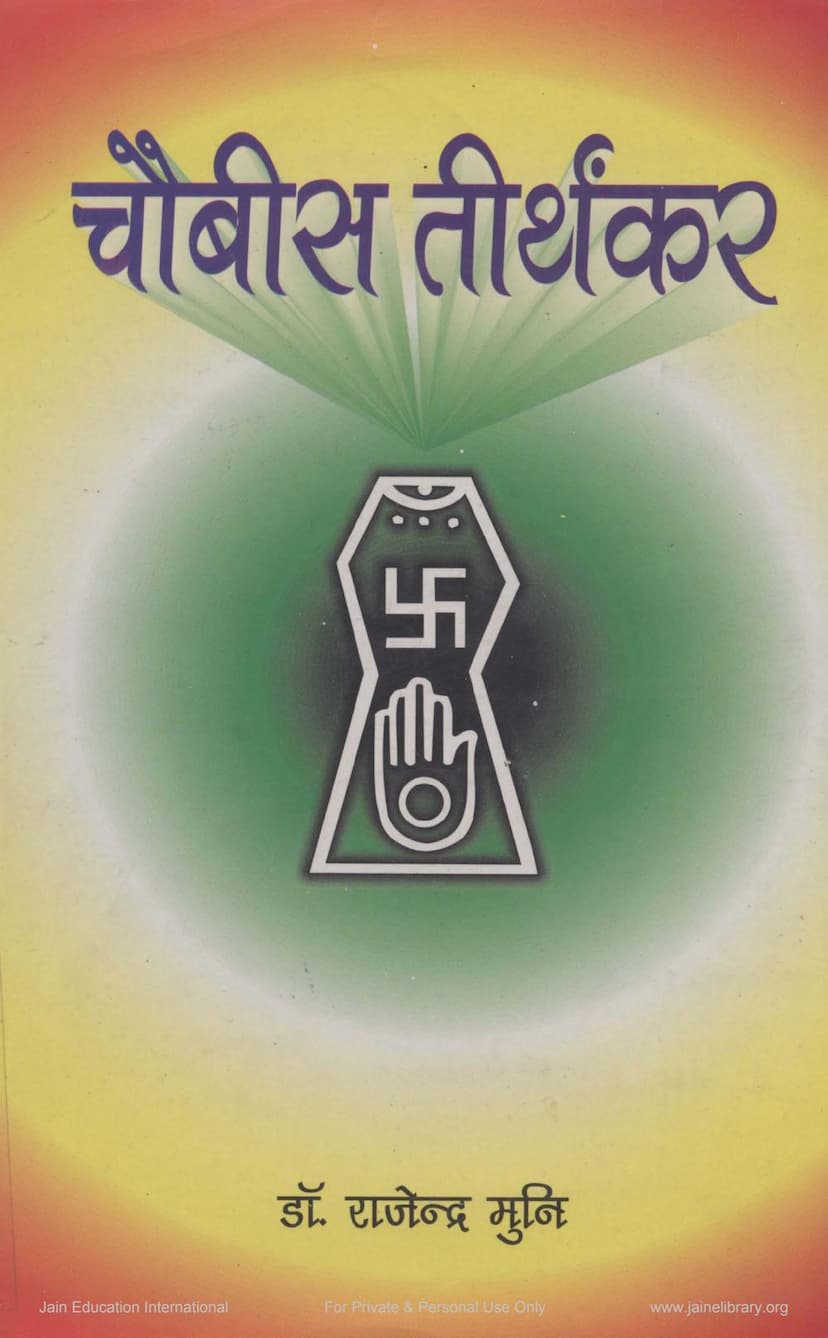Chobis Tirthankar
Added to library: September 1, 2025

Summary
Here's a comprehensive summary of the Jain text "Chobis Tirthankar" by Rajendramuni, based on the provided pages:
Book Title: Chobis Tirthankar (Twenty-Four Tirthankaras) Author: Dr. Rajendramuni Publisher: University Publication, Delhi
Core Concept of "Tirthankar": The book begins by defining the term "Tirthankar" in the Jain tradition. It's not merely a "holy place" as commonly understood, but a profound term derived from "Tirtha" (religious community or path) and "Kar" (creator or establisher). A Tirthankar is one who establishes and leads the four-fold Jain community: monks (Shraman), nuns (Shramani), laymen (Shravak), and laywomen (Shravika). Their greatness is described as immeasurable and beyond words.
Context of Time Cycles (Kalachakra): The author introduces the concept of the Kalachakra (Wheel of Time) which consists of two half-cycles: Utsarpini (ascending progress) and Avasarpini (descending progress). This cycle is explained using the analogy of a clock's hands moving from 6 to 12 (Utsarpini) and then from 12 to 6 (Avasarpini). Each half-cycle is divided into six "Aras" (eras). The text states that the 24 Tirthankaras appear in the third and fourth Aras of both Utsarpini and Avasarpini. The current era is identified as the fifth Ara of Avasarpini, characterized by a decline in spiritual fervor.
The Role of Tirthankaras: The book differentiates Tirthankaras from ordinary enlightened beings (Kevalis). While Kevalis achieve omniscience and liberation, Tirthankaras go a step further. They utilize their profound spiritual merit and knowledge for the welfare of the world. They guide humanity towards self-welfare and liberation, offering leadership on the difficult path to salvation. This altruistic approach elevates them to the unique status of Tirthankaras.
Historical and Philosophical Aspects: The text delves into various discussions:
- Religion and Philosophy: It explores the interconnectedness of religion and philosophy, drawing parallels with Western thinkers like Socrates, and emphasizing that in Indian thought, they are often inseparable.
- Jainism as an Independent Religion: The author strongly asserts that Jainism is not a branch of Vedic or Buddhist traditions but an independent and ancient religion. It counters arguments that suggest Jainism is a later development, highlighting its foundational principles like Ahimsa (non-violence) and Anekantavada (non-absolutism).
- The "Jaina" Terminology: It traces the evolution of terms used to refer to the Jain tradition, from "Vatarashana Muni" and "Arhat Dharma" to "Nirgrantha" and finally "Jain Dharma," noting that the term "Jain" itself appears later in historical records.
- Influence on Other Traditions: The book suggests that the concept of 24 figures (Buddhas in Buddhism, Avatars in Vedic tradition) might have been influenced by the Jain tradition's 24 Tirthankaras. It notes the similarities and differences, particularly in the varied numbering of Avatars compared to the consistent 24 Tirthankaras.
Detailed Biographies of Tirthankaras: The core of the book is dedicated to the life stories of the 24 Tirthankaras. Each Tirthankar's section typically includes:
- Previous Life (Purva-bhav): Descriptions of their previous births, highlighting the virtuous deeds and spiritual practices that led to their Tirthankar status.
- Birth and Lineage: Information about their birth place, parents, auspicious dreams, and family lineage.
- Household Life: Details of their life as householders, including their marriages and responsibilities, often emphasizing their detachment even amidst worldly pleasures.
- Renunciation and Initiation (Diksha): The moment of their decision to renounce worldly life and their acceptance of asceticism.
- Ascetic Practices and Austerities: The rigorous penances and spiritual disciplines they undertook.
- Attainment of Kevala Gyan (Omniscience): The moment of enlightenment and the associated celestial phenomena.
- First Sermon (Deshna): The core teachings and ethical principles they propagated, establishing the four-fold Jain community (Chaturvidh Sangha).
- Influence and Miracles: Accounts of their compassionate actions, the impact of their teachings, and instances of divine intervention or unusual events.
- Renunciation of Life (Parinirvan): The circumstances of their final moments, their death, and attainment of liberation.
- Religious Family (Dharma Parivar): Statistics of their chief disciples (Ganadhar), enlightened monks and nuns, lay followers, etc.
- Symbol (Chinh): The emblem associated with each Tirthankar.
Key Themes and Arguments:
- Karma and Rebirth: The underlying principle that Tirthankaras, like all beings, are products of their past actions (karma) and have undergone numerous rebirths to attain their exalted state.
- Detachment Amidst Worldliness: Many Tirthankaras, even those who ruled kingdoms and married, maintained a deep sense of detachment, living like lotuses in water, unaffected by worldly attachments.
- Ethical Foundation: The emphasis on core Jain principles like Ahimsa, Satya, Asteya, Brahmacharya, and Aparigraha as the foundation of Tirthankaras' teachings and their own lives.
- Historicality: The author presents arguments for the historicity of Tirthankaras, particularly Parsvanath and Mahavir, drawing upon Jain and sometimes Buddhist scriptures and the analysis of scholars.
- Influence of Jain Principles: The text highlights how Jain philosophical and ethical concepts, such as the emphasis on inner purity and the critique of ritualistic sacrifices, are believed to have influenced later Vedic and Buddhist thought.
- The Concept of "Nath": The book explores the meaning of "Nath" (lord or master) when appended to Tirthankaras' names, suggesting it signifies their role as spiritual guides and bestowers of welfare.
Structure of the Book: The book is structured thematically and then chronologically according to the 24 Tirthankaras. It includes an introduction discussing the nature of Tirthankaras and the Kalachakra, followed by detailed accounts of each of the 24 Tirthankaras, and concludes with appendices containing birth and lineage details, and timelines of their lives.
In essence, "Chobis Tirthankar" serves as a comprehensive biographical and philosophical exploration of the 24 guiding spiritual figures in Jainism, emphasizing their earthly lives, spiritual achievements, and their foundational role in shaping the Jain path to liberation.